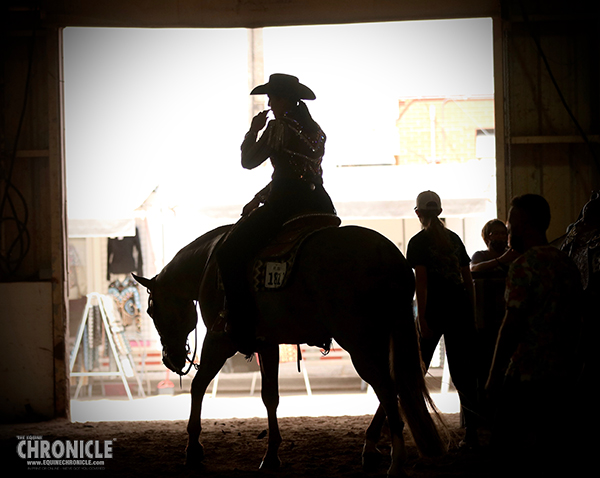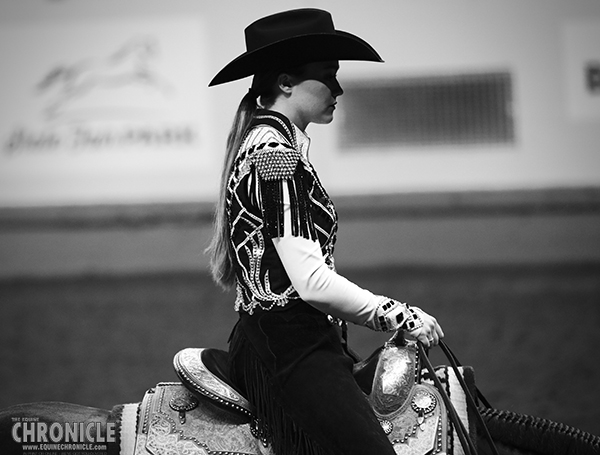Equality in the Equine Industry

Blog by: Kory Kumar
The plight of the solid horse born within equine color registries is not a new one. In the world of equine breed organizations, the term colored is a coveted and rewarded category of horse. Horses that are born with the requisite color or genetic information are given “regular registry” papers, and allowed to move into all levels of competition with their like colored or regular registry peers. Horses that are not born with the required color, or who do not have the required characteristics, or genetic information marking them as regular, are treated very differently, despite having been born from horses within the color breed association.
Over the years, the Appaloosa and American Paint Horse Associations have made provisions for the solid horses within their registries, who do not, or cannot, demonstrate the outlined standards of color requirements. These provisions, however, have been met with controversy time and time again. No matter the positive intentions of the people proposing change and voting for inclusion of the solid horses, the history of these associations shows continued disapproval of inclusion from its membership.
A study conducted by Stanford University found that members of any specific group are equally likely to be afforded an opportunity; however, within that same group, likelihood is very unequally distributed. The big question from this study for me is in determining if we should be concerned only with the issue of inequity of opportunity between groups, or if we should also be concerned about inequity between individuals within a group. When I read this study, I immediately thought of the solid registry horses and the systems that have been in place for years that branded them as less than their colored counterparts.
In the case of Appaloosa horses, the breed organization has had some fluctuation with rules/policies around embracing these horses and allowing them a more equal opportunity for participation in competition. The Appaloosa Horse Club was founded in 1938 by a small group of breeders and enthusiasts, but it wasn’t until 1983 that the ApHC accepted the Certified Pedigree Option (CPO) with additional fees, which allowed for solid horses to engage in competition equally with horses of color within the registry. Around 2006, this rule changed and the program was disbanded for solid foals born of outcross breeding with AQHA, JC or AHA, resulting in these solid horses no longer being allowed to show at ApHC sanctioned events. Then, in 2008, the Performance Permit program was created, which allowed for the inclusion of ALL solid Appaloosa horses being able to compete, but with a higher fee.
The American Paint Horse Association was founded in 1962 by a group of friends who were dedicated to preserving the color and stock type conformation of the horse breed. It wasn’t until the 1980s that solid APHA horses had a category for competition. The history of these solid horses has labeled them as “crop failures, breeding stock, and solid registry horses.” They historically report lower overall rates of registration than their colored peers, and are exhibited in drastically lower numbers. I can’t count the number of times I have heard, “too bad that one doesn’t have color.” For many years, APHA has operated under a separate but equal type of rationale with solid horses. While they are included at all levels of events within the organization, they are completely separated from the colored horse.
The American Paint Horse Association has done work to provide some solid registry horses with more opportunity. The association has passed rule changes to allow for a larger population of horses, which do not necessarily possess the required color, but are nonetheless APHA horses, a pathway for registration, thereby also allowing them participation in competition with their colored peers. While systems are currently in place, are they enough to ensure equality within the breeds? Do these systems promote the future breeding of horses, which will lead to the overall longevity of the breed?
Comparing these two particular breeds of horses opens the door to a lot of differing opinions from people, and fuels the fire of those individuals who feel strongly that inclusion of solid and colored horses is bad for the breed organizations. While a great many people feel strongly that the inclusion of solid horses ultimately led to the reduction of Appaloosa horses overall, there are other factors to consider, such as the change in our national economy, and the frequent turn around or changes in association rules regarding how solid horses were allowed to engage with colored peers at competitive events. For every person who says that these inclusionary practices negatively affected the ApHC, there are just as many people who feel that it saved the registry, and it was in fact other factors that caused any negative effects. One undisputable fact, however, is that ApHC saw a need and sought to fill it. They did something that other associations have been less inclined to do, which is to remove the inequity of value between horses born with color and those without it.
 In the book, Is Everyone Really Equal?, written by Ozlem Sensory and Robin DiAngelo, the dimensions of critical thinking related to knowledge are discussed. The authors wrote that “knowledge evolves over time and is dependent on the moment in history and the cultural reference point of the society that accepts it.” This acquiring of knowledge means more than just learning new things. In order to actually acquire knowledge, we must “determine the social, historical and political meaning given to those facts.” The thought provoking information within these pages was not intended for the equine community; however, the impact of these words on the community of solid registry horses is relevant nonetheless.
In the book, Is Everyone Really Equal?, written by Ozlem Sensory and Robin DiAngelo, the dimensions of critical thinking related to knowledge are discussed. The authors wrote that “knowledge evolves over time and is dependent on the moment in history and the cultural reference point of the society that accepts it.” This acquiring of knowledge means more than just learning new things. In order to actually acquire knowledge, we must “determine the social, historical and political meaning given to those facts.” The thought provoking information within these pages was not intended for the equine community; however, the impact of these words on the community of solid registry horses is relevant nonetheless.
While, I truly believe that the associations had only good intentions behind the division of horses based upon a criteria of color, they also created systems of inequity and inequality. In fact, the system of classification is actually social stratification, or the ranking of groups into a hierarchy of unequal values. For example, with means horses of color holding a place of higher value than those without it. It is a simple and understood fact of equestrians all over the world, that within a color breed association, a horse with regular registry or colored papers is more numerically valued than one without. Any breeder of American Paint Horses will tell you about the heartbreak involved in spending the thousands of dollars required to get a baby horse on the ground and having it born solid. Many APHA horse breeders will give solid horses away, as they are not overly marketable in the horse sales market. This has contributed to breeders moving to double registry horses resulting in many horses being American Quarter Horse Association horses, with American Paint Horses as a secondary registration. I’m not sure this was the intent of the original APHA founders.
While positive changes within the American Paint Horse Association have occurred over time, and the rules of registration have changed, giving the opportunity of value to more horses, have these changes been enough? Amidst the COVID-19 pandemic, APHA passed the Economic Stimulus Package granting additional pathways of regular registry to horses with color genetic markers and with only a single APHA parent. This has opened the door for a great many previously undervalued solid registry horses; however, did this change target the core group of solid registry horses that are so desperately in need?
If we critically examine the issue of inequity within the association related to solid and colored horses, there are several layers to consider. Critical thinking along these lines requires an informed perspective, after examining evidence and accounting for all the layers of complexity. First, consider the horses recently granted “regular or colored” registry. Were they also registered AQHA horses, implying their previous value added factor? Second, is the new registration pathway equitable for all solid horses? Are they all granted the same opportunity for the value added registration change? Third, does the new pathway for registration acknowledge and support the breeders within the industry who have in good faith spent a considerable amount of money to increase horses within the breed?
A horse is a horse, but within the color breed associations, not all horses are created equally. No matter the positive intentions of those behind the scene, there are major systems of oppression and inequity going on within our equine community. In the case of the solid registry horses, equestrians are concisely discriminatory toward them. By holding them at a lesser value, and by maintaining a separate but equal system of inclusion, these animals are disadvantaged.
Any oppressed group is one which is held down and denied full access and potential within a given society. The solid registry horses are living, daily examples of oppression within the equestrian industry. According to Sensoy and DiAngelo, “oppression occurs when one group’s prejudice is backed by legal authority and historical, social and institutional power.” It appears that the societal view of solid horses has changed dramatically over the last decade. I feel that granting solid and colored horses higher degrees of equal opportunity within an association also allows for a higher degree of contribution socially and economically from our community of equestrians. It also allows for the enhanced growth and prosperity of the horse breed, because we would be promoting our own breed of horse and rewarding those who are remaining faithful with breeding. “A good horse is a good horse, regardless of its color. And while color can be a major asset, a lack of color does not limit your opportunity for success with the American Paint Horse Association.” (APHA).
This topic is controversial, and I understand that people feel differently and strongly for a variety of reasons about solid and colored horses. I have had and loved solid and colored horses of my own for many years, and, in all honesty, I would not have my current partner, nor had the opportunity of ownership of some of these horses if they had been born with color. Our social construct has changed, my friends. Is the continued separation of these horses advantageous to our breed and association? I ask you to think deeply about that, and ask yourself what good can come from inclusionary practices. Perhaps, there will be unintended positive outcomes we had not considered; however, we will never know if we don’t step outside of our comfort zones and find out. I know many will disagree with me on this topic. My intention is not to fault your thinking or feelings, but only to offer a perspective shift for you to consider. Please walk away from any offense and look objectively at the issue. Perhaps I am wrong, and keeping things the same way as they have always been is the better option. There is really no way to know for sure unless we try.
Your Equestrian Sister ~ Kory Kumar
Related Topics:
If you would like to write a blog post for EquineChronicle.com, email B.Bevis@EquineChronicle.com for consideration.










